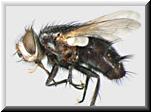Reared specimens examined. Spallanzania hebes (Fallén): One specimen from Alysham, Saskatchewan with pupal case of bertha armyworm pinned below it (undated but possibly 1948) (SRCS). Three specimens from Tisdale, Saskatchewan dated 14 July 1949, one with pupal case of bertha armyworm pinned below it (SRCS). These specimens evidently emerged from field collected pupae of bertha armyworm. New record.
The current classification of Spallanzania recognizes six species north of Mexico, two of which are recorded from Canada: S. hebes (Fallén) and S. hesperidarum (Williston). Undescribed species are known to exist. Spallanzania hebes, a species of Holarctic distribution, is newly recorded as a parasitoid of bertha armyworm. This species has not been recorded from Mamestra brassicae in the Palearctic region but is known to parasitize Noctuidae in both the Nearctic and Palearctic regions (Arnaud 1978, Herting 1960).
Recognition. Head similar in appearance to that of Gonia species. As in most members of the Goniini, Spallanzania species have large heads with a broad vertex in both sexes, haired parafacials, and reclinate ocellar setae (setae directed posteriorly). Species of Nearctic Spallanzania are further characterized by: eye bare, second aristomere less than half as long as third, male without proclinate orbital setae, prosternum haired, first postsutural supra-alar seta at least as long and stout as first postsutural dorsocentral seta, and katepisternum with four or more setae.
The two species of Spallanzania in Canada, S. hebes and S. hesperidarum, are readily distinguished from one another by features of the head. Spallanzania hebes has parafacial with scattered hairs, the width of parafacial is equal to 3X width of first flagellomere in both sexes, and facial ridge is only slightly haired (bearing decumbant, fine hairs). Spallanzania hesperidarum has parafacial with two rows of hairs, the width of parafacial is equal to 2X width of first flagellomere in both sexes, and facial ridge has erect hairs usually on 1/2 or more of its length.
The Nearctic species of Spallanzania were revised by T. Foard at the University of Georgia for a Master's degree in 1995. The revision has not been published but a copy of the thesis has been examined along with CNC specimens borrowed by Foard. The specimens of Spallanzania reared from bertha armyworm and here assigned to S. hebes are conspecific with specimens assigned to a new species by Foard. I am of the opinion that the characters upon which Foard's species is based are not reliable and believe the nominal species is synonymous with S. hebes. The name of Foard's "species" is not mentioned here because such usage would create a nomen nudum.
Biology. Spallanzania belongs to the Goniini, a tribe united by the specialized habit of producing huge numbers of very tiny ("microtype") eggs which are deposited on foliage and do not hatch until ingested by a host. Though Spallanzania hebes certainly shares these characteristics, more specific information is largely lacking. Only one host, Feltia subterranea (Fabricius) (Noctuidae), is recorded for this parasitoid in North America (Arnaud 1978). From the data accompanying the specimens of S. hebes reared from bertha armyworm, and our knowledge of the general habits of goniine tachinids, one can infer that eggs of S. hebes are ingested by bertha armyworm larvae during the summer or fall and adults emerge the following year from overwintered host pupae.
Distribution. Spallanzania hebes is widespread throughout the United States, Mexico, southwestern Canada, and the Palearctic region.


